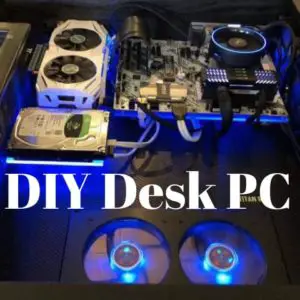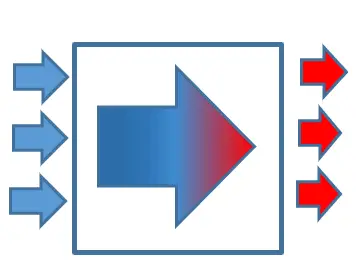Planning how cool filtered air will be introduced into your system and warm will be expelled is one of the first design decisions you will be faced with once you have settled on an overall design. We can overcomplicate this process (I have been guilty of this as well) but the fundamentals are pretty intuitive. Establish one side of the build as the intake and the other side as the exhaust.
Generally speaking, you will want the intake side to be close to your primary heat generating components so as to quickly and continuously introduce fresh cool air around them. At the opposite end of the desk, you want to have fans that are steadily pulling the warmer air away and out of the desk.
We toyed with several different approaches to airflow and ambient temperature control but this was the logical approach that we finally settled on. We did, however, determine that it requires a significantly larger number of fans to push cool air in than to exhaust that same volume. This is due primarily to the filtering systems that are employed on intake fans to reduce the introduction of dust. An open exhaust fan easily moves more volume than a filtered intake fan. You can manipulate this ratio to some extent with static pressure blades and fan speed but to ensure a neutral or even positive pressure within a build you will want to account for additional intake fans to offset this variance.
More fans are better -you can always back off on speed
Here’s where the importance of this ratio breaks down. If you design your desk with minimal airflow in mind and only include two to four fans to be divided equally between intake and exhaust, you may be able to successfully move some air. It certainly won’t be a wind tunnel and you will likely notice increased ambient temperatures around the components as heat buildups up inside. A lack of air pushing the warm air away combined with an insufficient pull of that warm air out of the system through an effective exhaust will only allow the warm air to remain and continue to increase the ambient temperature. When planning the airflow aspect of your system, ensure adequate airflow by increasing the number of fans that can be stalled for both intake and exhaust. Since you are dealing with a large surface area inside the desk case you will want to make certain that you adequately compensate with fans that will move more air through this area.

Assuming a basic rectangular desk design, cool filtered air should be pulled in from at least one side, preferably on the side where the motherboard and GPU are mounted to provide cool replacement air to these parts as quickly as possible. Warm air should then be exhausted from the other side so that it is steadily pulling the warm air away from these parts.
The simplicity of this analogy does not, however, consider air gaps that may exist throughout the system. Just like practically every manufactured PC case on the market, desk PC cases can also be prone to the diminishing results of air movement due to air gaps. In fact, one of the key benefits of building a custom desk PC is that you can design it so as to better control the movement of air and reduce the number of air gaps in the system.
In any case, this graphic demonstrates how the air would flow ideally through your system, warming as it moves across and away from the components and exhausting out the other side.
Air gaps and Filtered Intake Requires More Fans
In a perfect world, you could have an equal number of intake and exhaust fans pulling a steady cool breeze over your PC components in perfect harmony. But this is where we run into variables, and variables change the rules of the game.
First, you are pulling in filtered air and due to the resistance of dust protection filters, you are in fact pulling in less air per cubic foot than your exhaust fans are pushing out. This will result in negative pressure within the system because the exhaust fans have no resistance to push against since they are not filtered. When this scenario occurs, your exhaust fans compensate by pulling in additional air through the numerous air gaps throughout your build. This not only introduces dust into your desk through unfiltered air, but it also reduces the purposeful airflow over the components. Consider this – each of those airgaps result in a simpler way for air to enter the system than the filtered intakes resulting in less pressure on those intakes to pull in filtered air. I’m sure you have heard the saying that electricity follows the path of least resistance, right? Well, guess what. So does water…. and air. (And unfortunately, humans too more often than not but that’s a topic for another time). The point is this, if you design your system with an equal number of intake and exhaust fans and set all of those to run at the same default speeds, you are not creating a balanced air system like so many people believe. You are creating a negative air system where air will bypass the filtered intake and find its way in through cracks, crevices, and expansion ports.
There are ways to compensate for this. First, you can adjust the fan speeds to ensure that the filtered fans are pushing air in at a rate equal to or less than the unfiltered exhaust. This sounds simple enough, but once again variables come into play. First, raising the speed of your intakes increase noise. Reducing the speed of your exhaust fans lowers the air exchange rate for the system. Are you starting to see the challenge here? Remember that our initial goal was to move air consistently across the components and out of the system. Plus, we still need to account for the air movement either in or out of the system through air gaps which likely means increasing our filtered intake fan speeds even more. These variables are making that complicated!
OMG What Should I Do?????
As frustrating as this all sounds, there is a solution. We discovered it through trial and error. Our initial design for our desk PC case included 8 fans. The plan was to follow the course of logic and have 4 fans near the components pulling cool filtered air in and 4 exhaust fans toward the middle and opposite end to exhaust the warm air. We made adjustment after adjustment, but this is where we finally ended up. We added a 9th fan and set 7 of the 9 to a filtered intake. That left us with 2 fans exhausting the warm air. This goes against logic until you account for the resistance of the filtered air and the air gaps. We wanted to ensure positive pressure in the system. We did take some time to air tighten many of those air gaps, but a couple of significant ones remain. We also reduced the speed of the exhaust fans significantly (on a curve of course – they speed up as the system goes under load along with the intake fans to compensate for increased heat). For us, this balance hit the sweet spot. The system steadily pushes cool filtered air into the case and the 2 exhaust fans remove the warm air. We have an old-style thermometer in the system to monitor ambient air and we have been very pleased with the temps overall.
So, what’s the lesson here? I believe what I’ve learned and what I would encourage you to take away from this post is that you need to plan to minimize air gaps in your system, plan for significantly more filtered intake than exhaust, and be willing to play a little with the speed fans to finetune that perfect air exchange balance.
The same holds true for manufactured PC cases. Don’t assume that those folks have already figured all of this out for you. Their primary goal is design and looks, not ambient temperatures. You invest a lot of money into your computer components, showcase them in a build that not only highlights their looks but provides an ambient temperature environment that ensures their longevity.
Note – airflow is a controversial topic and even in this day and time our understanding of how best to address heat issues in a system is evolving. I will be updating this site with continued research and findings. Look for airflow in the categories area of this site to see all postings related to this topic.


